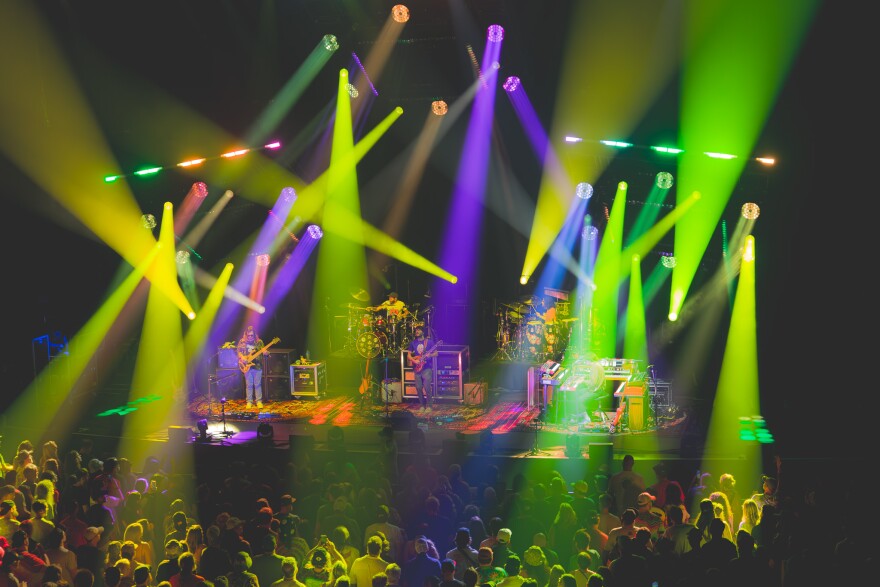When Connecticut-based jam band Goose launched its summer tour at the Factory in Chesterfield earlier this month, the show sounded and looked great for fans in the room and those watching a live webcast from home.
Few fans knew the sights and sounds arrived, in part, through the work of a company based just down the road from the venue.
As Goose took the stage in Chesterfield, it did so with an enhanced lighting rig developed in tandem with Gateway Studios & Production Services in Chesterfield. The shows were filmed and livestreamed with video equipment sourced and provided by Gateway. The company also sends a few technicians to help things run smoothly on the road.
“I always wanted to be a roadie. That’s all I ever wanted to be,” Gateway CEO Trey Kerr said.
Kerr is a St. Louis native who turned his lifelong passion for live music into a career. Now he helps some of his musical heroes achieve their production goals.
With a boost from outside investment, Gateway grew out of Kerr’s smaller outfit, 201 Productions, in 2021. Gateway employs 75 people year-round, plus as many as 300 additional contractors working on specific tours.


Gateway also is building a $120 million studio complex in Chesterfield designed for national and international touring acts to develop and test out their productions. After a few construction delays, it is slated to open in early 2025. Through a representative, the company declined to identify its owner or other financial backers.
As a Phish fan with ambitions to work in the industry, Kerr talked his way onto the band’s road crew more than 20 years ago. He wore various hats for Phish and its frontman Trey Anastasio’s solo band before becoming Phish’s video director, directing live webcasts from a truck backstage.
When Kerr stepped away to start his own company, Phish became one of its first clients.
He still takes to the road with the band to direct live webcasts of its every show.


Goose in Chesterfield
Gateway also performed lighting and video services when Anastasio and Goose launched a co-billed tour in 2022 — a much-noticed excursion that many fans, with varying mixes of solemnity and good humor, described as the elder jam statesmen passing the torch to the high-flying newcomers.
There was an extra buzz around Goose’s tour kickoff at the Factory, in part because of the arrival of new drummer Cotter Ellis. Like most of the band’s recent tours, it includes some of the largest venues the band will have ever played.
At 8 a.m. on the day of the first show, crew members drove equipment trucks into loading bays behind the stage and began rolling out scores of heavy, black equipment cases.
“Today’s Day 1, baby,” Eric Loomis, Goose’s production manager and front-of-house sound engineer, said a few hours later. “We’ve put so much time and effort into the design of our production. Now we’ve got all the gear in all the trucks, and we’re ready to get out there and show ’em how it’s done.”
Many of the crew members work for Klance Unlimited, a production company based in Pacific, Missouri. In other cities, different companies step in to do the setup work.
The first four hours of work went toward attaching lighting instruments to trusses that temporarily sat on the stage. Lighting crew chief Peter Spadaro, a Gateway employee, supervised the installation. Goose’s setup has three central lighting pods; as each was hoisted into the air, lighting director Andrew Goedde began testing it out while workers below finished hooking up the other trusses.
The lights are particularly important to Goose and Phish shows. Chris Kuroda, Phish’s lighting designer, is considered one of the best in the business. Kuroda and Goedde each map out ideas for upcoming tours and work with Gateway to find just the right gear.

Goose has a much smaller lighting setup, but like Kuroda, Goedde needs to know his band’s music well enough to improvise along with the musicians. Each show is unique.
“It definitely adds to the excitement,” said Peter Anspach, who plays keyboards and guitar with Goose. “When the lights are flashing and the music is going crazy, I’m like, this is the perfect light rig and light show for this moment. It’s just matching up.”
With the lights finally off the stage a bit after noon, workers began unpacking musical equipment, known as backline.
Klance and Gateway workers wheeled road cases onto the stage, each marked in stencil with its contents. Strips of color-coded tape divided the boxes into categories, with supervisors directing a complicated ballet of wheeling cases onstage, unpacking and assembling gear, and wheeling cases back to the trucks.
Lead guitarist Rick Mitarotonda stood at center stage, testing out new gear in his rig. Ellis soon turned up to start checking out his drum domain.
The Factory is smaller than most venues on Goose’s tour, without enough room for the video crew to set up side-stage. Instead, Goose video director Jon Lombardi and crew crammed into a loading bay behind the stage, setting up a temporary command center. It included a video console with view from five cameras, a station to control robotic cameras and a color-correction station where Gateway’s Fernando Cornejo Vazquez would later adjust camera colors in real time.


Twenty minutes after venue doors opened to the audience at 7 p.m., Loomis arrived at the soundboard near the rear of the open floor and slapped a laptop sheathed in a rugged case onto a desktop. Next to him was Goedde’s lighting console, lined with digital monitors showing his controls. On one corner of the workspace sat a stuffed unicorn.
Three hours later, Goedde turned down the houselights, sparking a roar from the crowd of about 3,000 fans. Goose took the stage and Anspach greeted the crowd: “How we doing, St. Louis?”
More than 14 hours after the crew arrived on-site, the long day's journey into jam was complete.





